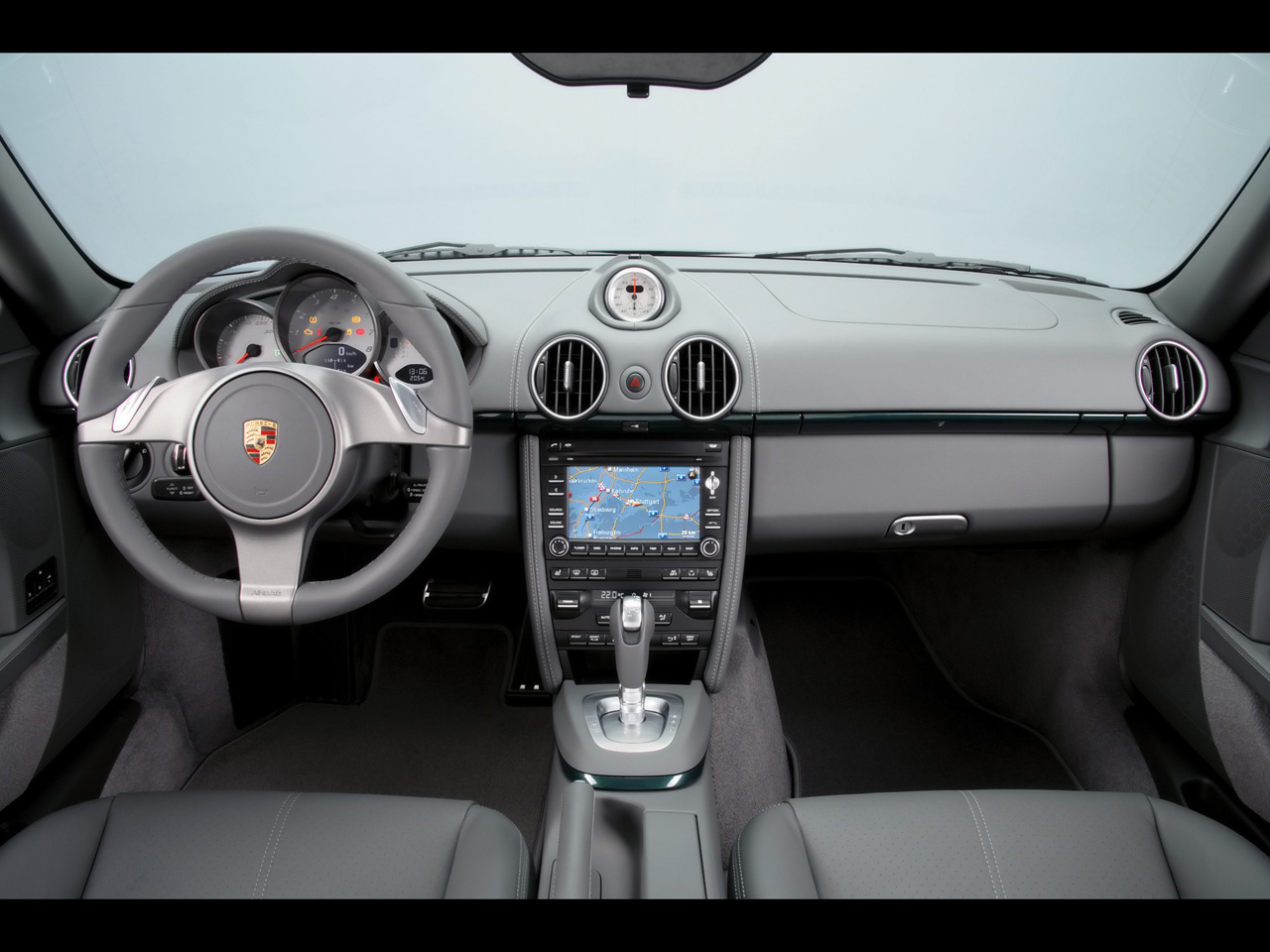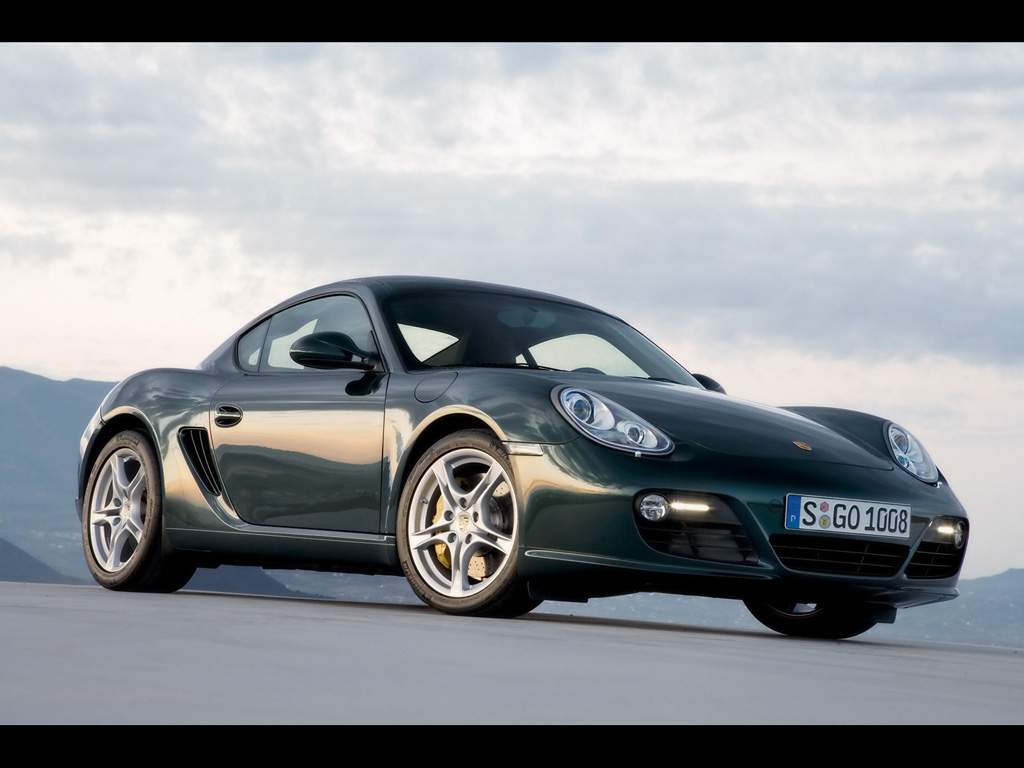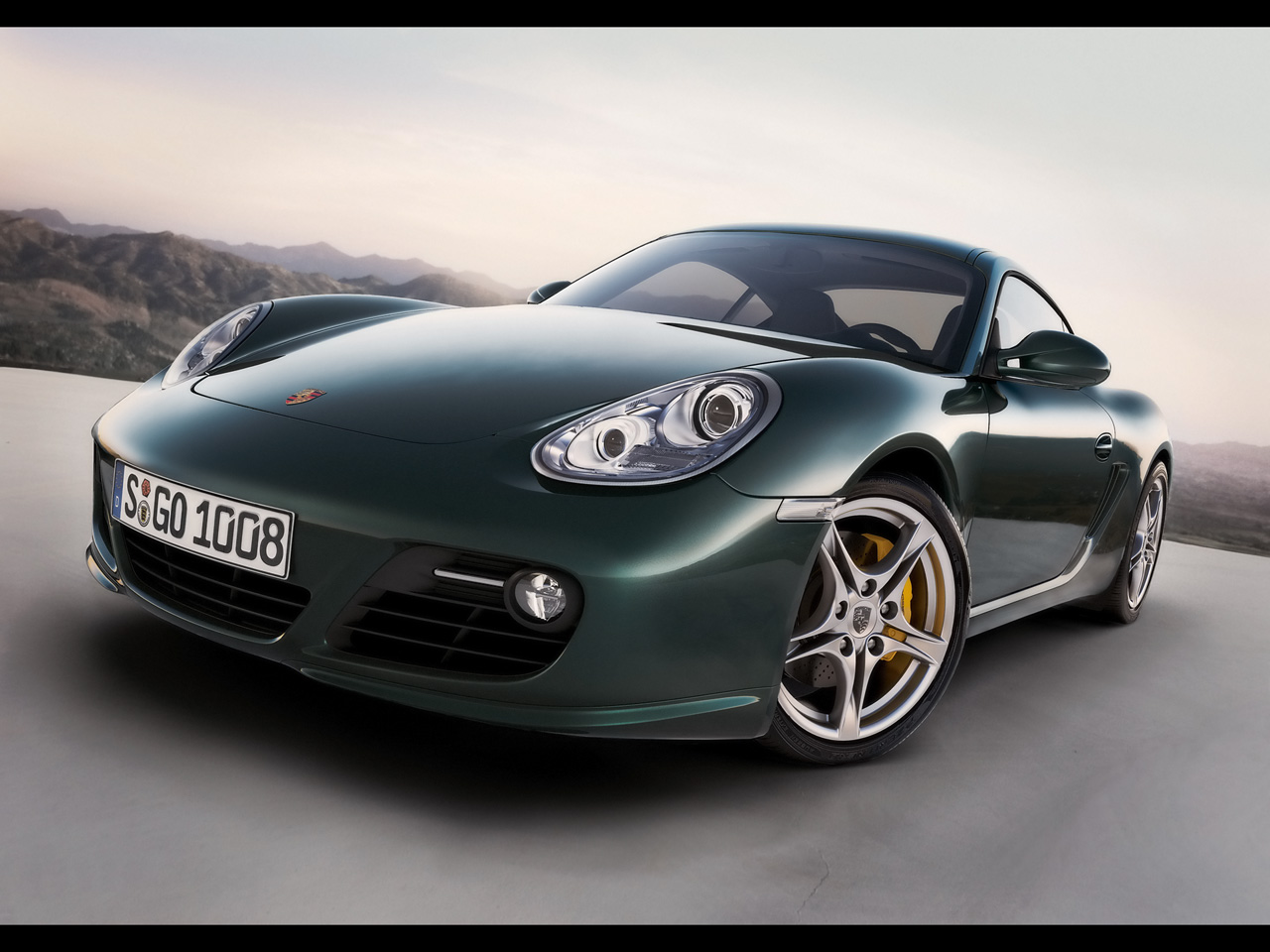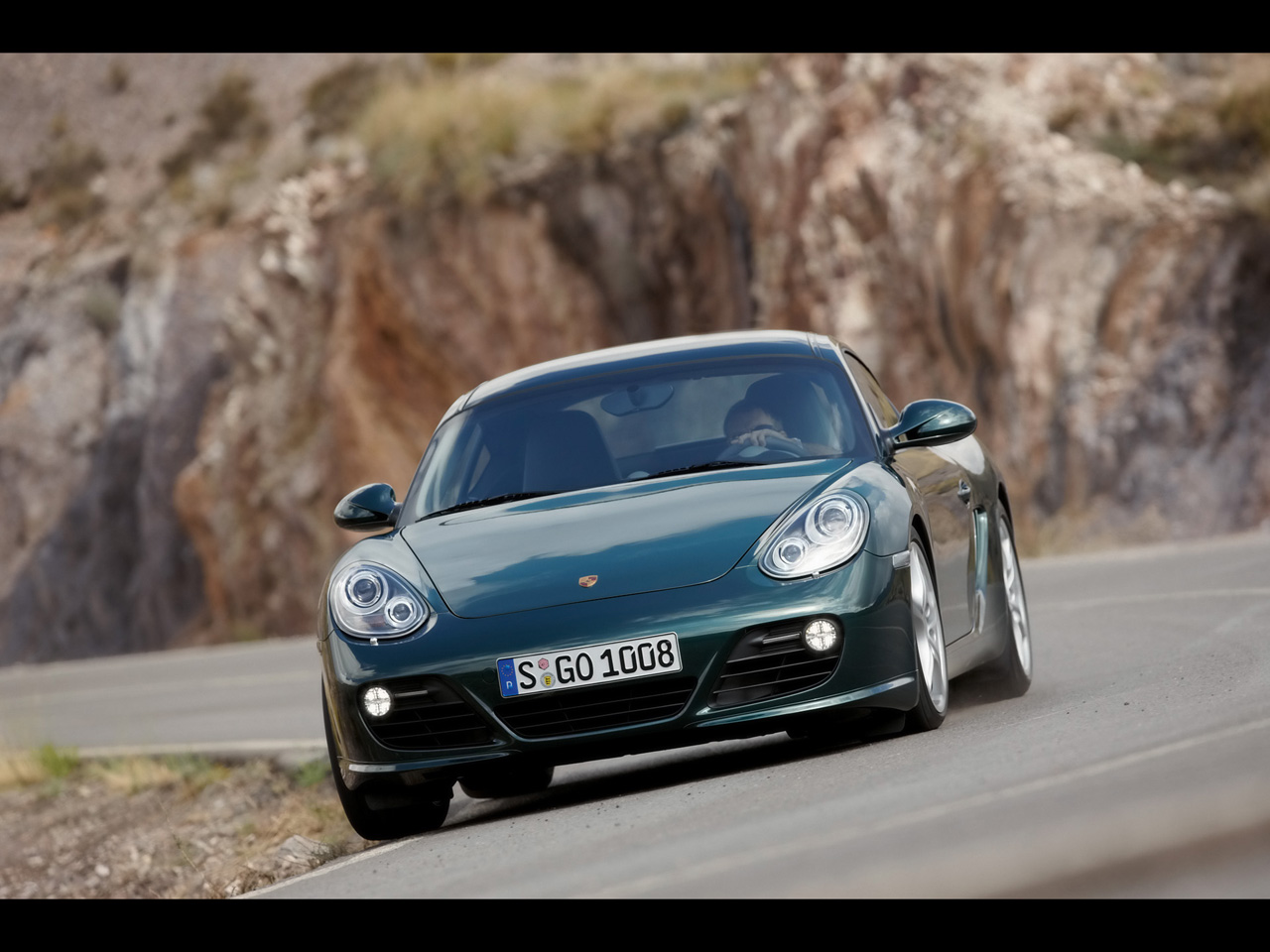2009 Porsche Cayman S
|
Price |
-- |
Production |
-- | ||
|
Engine |
3.4 liter boxer-6 |
Weight |
-- | ||
|
Aspiration |
natural |
Torque |
-- | ||
|
HP |
320 hp |
HP/Weight |
9.3 lbs per hp | ||
|
HP/Liter |
94.1 hp per liter |
1/4 mile |
-- | ||
|
0-62 mph |
4.9 seconds |
Top Speed |
-- |
(from Porsche press
release) Next generation Porsche Cayman with increased power
and efficiency
Porsche is presenting the second generation of the mid-engined
Cayman sports coupe at the Los Angeles Motor Show (November 21 – 30)
this week. The highlight is the new, flat-six ‘boxer’ engines,
developed to incorporate new technical features from the ground up,
providing not only more power, but also significantly greater fuel
efficiency.
A further improvement of both fuel economy and performance is
guaranteed by the Porsche Doppelkupplungsgetriebe (PDK), the new
double-clutch gearbox now available as an option on both the Cayman
and Cayman S.
Newly-developed’ boxer’ engines deliver more power on less fuel
The Cayman now has an
engine displacing 2.9-litres, which develops 265 bhp (195 kW), an
increase by 20 horsepower over the prior 2.7-litre model.
The 3.4-litre power unit in the Cayman S now features Direct Fuel
Injection, and delivers 320 bhp (235 kW), up by 25 bhp.
These developments see the engines fitted to the Cayman and Cayman S
coupes offering more horsepower than those in the Boxster roadster.
This move emphasises the sports driving orientation of the Cayman
and further differentiates the coupe.
An outstanding power-to-weight ratio of 4.2kg/bhp on the Cayman S in
particular ensures optimum driving dynamics. For example, the Cayman
S with PDK and Launch Control (featured in the optional Sports
Chrono Package Plus) accelerates from 0-62mph (0-100 km/h) in 4.9
seconds, setting the benchmark in the range.
When combined with the PDK transmission, the new 2.9-litre engine of
the Cayman clearly breaks through the 30.0mpg fuel consumption
boundary. Indeed, the figure of 31.0mpg (9.1 litres/100km) is
approximately 10 per cent better than the previous model with the
Tiptronic S automatic transmission. Increasing fuel economy by an
even more significant 15 per cent to 30.1mpg (9.4 litres/100km), the
3.4-litre Cayman S with PDK offers an even greater saving over its
predecessor with Tiptronic S.
In parallel with the improvement in fuel economy, so emissions of
the engines have decreased also. Depending on model, emissions have
been reduced by up to 16 per cent. The Cayman with the standard
six-speed manual gearbox emits 221g/km CO2, and 214g/km CO2 when
fitted with PDK. The Cayman S manual emits 223g/km CO2, and 221g/km
CO2 with PDK.
Significantly, these developments move every Cayman model – whether
manual or PDK – into Band F for Vehicle Excise Duty and company car
taxation purposes.
Direct Fuel Injection standard on 3.4-litre S engine
The driver benefits from
a further advantage of direct injection every time they touch the
throttle pedal: with fuel being injected fractions of a second prior
to combustion, the engine responds more directly and spontaneously
to even the slightest movement of the driver’s right foot. This is
not only the case when accelerating, but also when lifting off the
throttle, for engine speed drops more quickly and smoothly since
there is no residual fuel left in the intake manifold which might
otherwise prolong the combustion process.
Depending on engine load and speed, fuel is injected into the
combustion chamber at a pressure of 120 bar. The big advantage is
that unlike conventional intake manifold injection, direct fuel
injection serves to form the fuel/air mixture directly in the
combustion chamber. This better mixes the air and fuel in the
cylinder, establishing an important prerequisite for clean and
complete combustion. This ensures the ‘homogeneous’ operation of the
power unit with a consistent balance of the fuel/air mixture in the
combustion chamber at all times and under all running conditions.
Such smooth operation guarantees optimum combustion and maintains
low emissions, across a range of fuel qualities.
A coupé of distinction
While instantly
recognisable as a Porsche sports car, the Cayman is individual in
its design. Originally launched in 2005, the characteristic
silhouette of the Cayman has remained fresh and contemporary. Its
distinctive coupé lines are combined with a long wheelbase and a
rear aspect that slopes gently downwards. From the rear, the Cayman
is defined by a large, opening rear lid, powerfully sweeping wheel
arches and an automatically extending spoiler.
The rear lid opens upwards to provide access to the 260 litre
luggage compartment. This, in conjunction with the 150 litre
capacity luggage compartment in the nose, plus numerous additional
storage compartments, ensures that this two-seater sports car
combines real functionality with elegant aesthetic form.
As is Porsche tradition, the styling of the next generation
two-seater Coupe has evolved subtly. However, it is clearly
distinguishable from outside through its newly-designed nose and
tail. The new halogen headlights with their integrated direction
indicators are reminiscent of the lights on the Carrera GT, and the
new LED rear lights tapering to the outside are integrated elegantly
in the remodelled bodywork.
The rod-shaped side lights in LED light conductor technology add
distinction to the car’s looks, which are further enhanced through
their horizontal arrangement in the outer air intakes. Yet a further
highlight is provided by the round fog lamps featured as standard.
For the first time the Cayman is available with a Lights Package
featuring bi-xenon headlights, dynamic cornering lights and LED
day-time driving lights. Replacing the fog lamps, these light units
are made up of four LEDs arranged in round light units like the eyes
on dice.
PDK: quickly shifting gears, reducing fuel consumption
The Cayman is available
with the Porsche-Doppelkupplungsgetriebe (PDK) carried over directly
from motor sport, and replacing the former Tiptronic S torque
converter automatic transmission. When equipped with PDK, the Cayman
accelerates from 0-62 mph (100km/h) 0.1 seconds faster than with the
manual six-speed gearbox.
Acceleration is particularly fast and dynamic with the optional
Sports Chrono Package Plus featuring Launch Control; this offers
maximum acceleration from a standing start and also a Race Track
Gearshift Strategy for the fastest conceivable gear change as an
exclusive highlight on the PDK models.
Benefiting from Launch Control, the respective models accelerate
from a standstill to 62 mph (100 km/h) yet another 2/10ths of a
second faster.
Porsche Doppelkupplungsgetriebe (PDK) – in detail
The next generation
Cayman and Cayman S are available for the first time with the new
Porsche Doppelkupplungsgetriebe (PDK), literally Porsche
double-clutch gearbox. Offering no less than seven forward gears,
the new gearbox combines the driving comfort of a torque
converter-equipped automatic transmission with the dynamic manual
gearshift functionality of a sequential racing gearbox. PDK also
boasts an entirely automatic gearshift function, and replaces the
Porsche Tiptronic S automatic transmission previously offered.
Through its optimised and adaptive gearshift programmes, PDK further
improves the acceleration of the Cayman models and reduces fuel
consumption to an even lower level.
In principle, the PDK consists of a conventional manual gearbox and
a hydraulic control system divided into two separate transmission
units. Two wet clutches in radial arrangement, controlled
hydraulically, and using oil for both cooling and lubrication, form
the heart of the transmission. One clutch is for the first
transmission unit with the uneven gear ratios (1,3,5,7) and reverse,
and the other clutch is for the second transmission unit with the
even gears (2,4,6). Via a number of pressure valves, the hydraulic
control unit masterminds both the wet clutches and the shift
cylinders activating the transmission ratio required.
The gearshift perceived by the driver comes not from the gears
actually changing, but from the change of positive clutch
engagement. In this case, the clutch on one transmission opens or
disengages while the clutch on the other transmission closes or
engages in a simultaneous process. The big advantage is an even
faster gearshift than with a conventional manual gearbox or torque
converter automatic transmission. The gears are already ‘in mesh’
when shifting and the power of the engine need not be interrupted in
the process.
PDK also reduces to a minimum transmission power loss courtesy of
the high standard of mechanical efficiency in the double-clutch, and
this manifests itself in fuel economy improvements of approximately
13 per cent compared with a conventional Tiptronic S transmission.
PDK also offers an advantage in terms of weight – despite two
additional gears, it weighs 10kg less than Tiptronic S.
To use the various functions of the double-clutch transmission, the
driver can either shift gears by means of sliding buttons on the
spokes of the new steering wheel, or via the new gear selector
lever. The driver can press forwards to shift the gears up, and
press them from behind to shift downwards. Alternatively, pushing
the gear selector lever forwards shifts up a gear, and pulling it
back shifts down. The option of PDK costs pound;1,961.
This PDK gearshift principle was first developed by Porsche for
motor sport 25 years ago. Porsche works drivers benefiting from this
technology were able to accelerate faster than their competitors and
keep both hands on the steering wheel while changing gears, thus
avoiding even the slightest distraction while shifting.
The seven-speed PDK shifts gears up to 60 per cent faster than a
conventional automatic transmission, and naturally, gives the new
Cayman models even better performance. And those in search of
optimum driving dynamics have the option to combine PDK with Sport
Chrono Package Plus, now featuring Launch Control.
Dynamic suspension and supreme brakes – new option of limited-slip differential
The suspension with its
new set-up gives the new Cayman models a combination of even greater
driving dynamics and enhanced comfort all in one. Modification of
the valve control map on the steering gear serves furthermore to
reduce steering forces, giving the Cayman more agile and spontaneous
steering behaviour.
The wheels come in new designs and are half an inch wider than
previously on the Cayman 2.9-litre model in order to accommodate the
larger brake system of the S-models which are now fitted on the
front axle. The Cayman and Cayman S feature the latest generation
Porsche Stability Management (PSM) which now offers two new
functions: Brake Pre-Loading and the Brake Assistant. Whenever the
driver lifts off the throttle pedal very quickly – which is typical
immediately prior to an emergency braking manoeuvre – the PSM
hydraulic control unit builds up an appropriate level of pressure in
the brakes before the driver even presses the brake pedal down,
which has the effect of moving the brake pads slightly towards the
discs, and ready for immediate action. This significantly improves
brake response and shortens stopping distances accordingly.
When recognising that the driver is braking in an emergency due to
the very fast operation of the brake pedal and a defined brake
force, the PSM hydraulic control unit actively delivers the brake
pressure required for maximum stopping power.
In conjunction with 18- and 19-inch wheels, the new models in the
Cayman range are also available with a limited-slip differential on
the rear axle. Locking action is 22 per cent under power and 27 per
cent in overrun. This significantly improves both traction and
stability, providing a substantially higher level of performance on
winding roads, particularly on the race track. A further advantage
is the more stable load change behaviour. At the same time, the
mechanical differential, through its particular function, interacts
perfectly with the electronic Automatic Brake Differential (ABD) for
optimum traction control, the locking action delaying the tendency
of one wheel to spin on a road surface slippery only on one side.
New audio and communication systems
The next generation
Cayman features as standard the new CDR-30 CD radio. The new Porsche
Communication Management (PCM) 3.0 complete with hard disc
navigation is available as an option and when specified serves as
the central control unit for all audio, communication and navigation
features.
PCM 3.0 is more versatile, efficient and easier to use than before,
standing out in particular through its touch-screen which enables
the driver to select specific functions simply by pressing the
appropriate key on the larger 6.5-inch monitor. PCM 3.0 is available
with highly convenient voice control and, in conjunction with the
optional, universal audio interface, can now be used also to control
external audio sources such as an iPod®, USB stick, or Bluetooth.
Seat ventilation combined with seat heating is also available as an
option.



